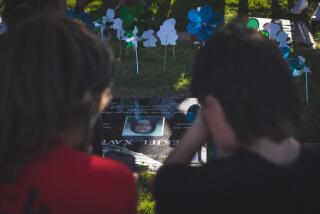Giving Kids With One Strike Against Them a Chance at a Home Run
- Share via
A LOT OF US NEVER GAVE RICKY A CHANCE.
From the day he was born--runty, jaundiced and syphilitic--we wrote him off as a little monstrosity who’d never love or learn, one of a lost cohort of babies ruined by the crack cocaine their mothers had smoked while pregnant.
Now, five years later, here he is--shirtless in the sun, taking turns with two other small boys swooshing down the slide in the play yard of a South Pasadena preschool. He is tall for his age and has curly black hair. His eyes are dark and luminous, his smile merry. He is fascinated with science and nature; LAUSD aptitude assessors have suggested he be tested for the gifted and talented program when he reaches second grade.
When he hears his adoptive mother as she approaches (“Where’s my guy?” she calls. “Where’s my guy?”), Ricky quits his play, takes a running jump into her arms and hugs her head.
A lot of us apparently got it wrong.
A decade ago the crack-baby scare cast a shadow like a great, dark bird in flight on a large segment of an emerging generation. Prenatal exposure to the drug, said one researcher, “was interfering with the central core of what it is to be human.” A pretty hopeless prognosis.
Cocaine use during pregnancy no doubt is harmful to fetuses. At least some of the children thus exposed will likely need special help to combat their stronger tendency toward distractibility, hyperactivity and impulsiveness as they move through their school years.
Some researchers caution, however, that the effects of prenatal exposure to cocaine aren’t so easily teased out from the effects of exposure to alcohol (which commonly accompanies cocaine exposure), and of the postnatal neglect or abuse many of the children experienced. In any case, it is becoming clearer that cocaine-exposed children, far from being unsalvageable wrecks, can thrive in the hands of loving, dedicated and well-prepared parents.
Gathering on a recent evening, Ricky’s mother and five other adoptive parents of similar children could hardly contain their pride in the educational and behavioral achievements of the four girls and two boys they rescued from the landfill of our dread expectations.
The adults participate in UCLA’s Training, Intervention, Education and Services (TIES) for Adoption program, which drills adoptive parents in the realities of their drug-exposed children’s special needs and provides assessment, counseling and medical services.
The TIES parents, clearly a highly motivated lot, were undeterred by the litany of past and potential problems recited to them before they adopted their children. “I wanted that little girl,” said the adoptive single mother of a thriving 7-year-old. “I said, ‘I don’t care what you tell me, I’m taking her.’ ”
In its five years, TIES has touched the lives of 300 children. Parents who’ve encountered the predicted problems say that TIES’ services have helped make the difficulties manageable. In March, TIES director Susan Edelstein was named Outstanding Practitioner of the Year by the National Assn. of Social Workers’ California chapter. But funding has been intermittent, and only 75 of the 300 children and their adoptive parents have had the full array of TIES’ services.
IN A 1997 UC BERKELEY SURVEY OF THE adoptive parents of 135 prenatally drug-exposed children and 112 non-drug-exposed children, 90% of each group said they’d adopt their children again. Of the 75 adoptions fully serviced by TIES, only one has come apart.
This has important implications for the 8,600 adoption-ready children in L.A. County, a “significant percentage” of whom, according to adoption officials, were exposed to drugs in the womb.
A bit of math: TIES’ budget is $340,000 a year. We are about to give the Colombian military $1.5 billion to intensify their notably ineffective fight against cocaine production. That sum, which represents less than 10% of the cost of America’s war on drugs, would fund 100 TIES programs across the U.S. for more than 40 years. If we’re not stopping the flow of illegal drugs, shouldn’t we focus on helping those who’ve been damaged by them?
In 1998 the California Legislature enabled TIES to be replicated throughout the state. But unreliable year-to-year funding and cumbersome bureaucratic procedures have stymied the endeavor.
In the meantime, prenatally cocaine-exposed children still bear a stigma, which is why TIES parents are adamant about concealing their sons’ and daughters’ pasts from strangers and casual acquaintances.
“My son is a poster child for what these children can be,” Ricky’s mother says. “I look forward to the day when he’s a rocket scientist and I can tell everybody everything, and flip them all the middle finger.”
*
James Ricci’s e-mail address is [email protected]






